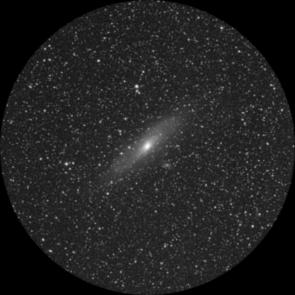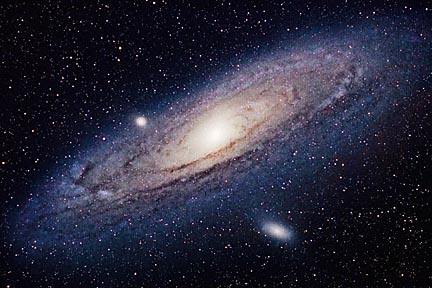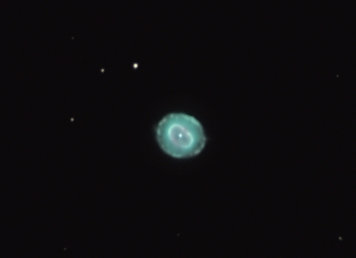
The Andromeda Legend


|
The Andromeda Legend |

|
Let's go hunt for a galaxy... if it's a good, clear night you can see this
one just by looking -- which makes it the farthest thing you can see with your
eyes, at 2 MILLION light years away.

You need a good, dark sky to see the galaxy by eye, but it is easy to find in binoculars. In fact, it looks best in a good pair of binoculars, 10x50 or bigger. It is also an easy target for the telescope. If you look hard in the telescope you might see one or two smaller fuzzy patches near Andromeda. These are satellite galaxies, little galaxies orbiting the big one! Our galaxy, the Milky Way, has satellites of its own, called the Magellanic Clouds. They can be easily seen, looking like detached portions of the Milky Way, but they can be seen only in the Southern Hemisphere.
| Andromeda in Telescope | What you're looking at |
 |

|

Another star of interest is u (upsilon) Andromedae, a star very similar to our own sun {point out u Andromedae}. In 1999 three planets were shown to be orbiting u Andromedae, making this the first system of planets to be discovered outside our own. (We can't see the planets in our telescope - they were found by calculation from the motion of the star).
| Snowball in Telescope | What you're looking at |
 |
 |
This is another planetary nebula, like the Ring Nebula. They are called planetary nebulae because the disk shape suggested the look of a planet to early astronomers. In fact it has nothing to do with planets at all. This is what's left of a red giant star that, about 1700 years ago, did what all red giants eventually do. When the fuel at the core runs so low that the nuclear reactions can no longer hold up the weight of the star, it all collapses in to the center, which in turn raises the temperature so high that the star blows off its outer envelope of gases, losing much of its mass. This exposes the core to outer space, or, more accurately, exposes outer space to the nuclear reactions going on at the core. The intense radiation from the burning core causes the expanding shell of gas to light up like a neon light, and voila -- the faintly glowing disk that you see here. With a larger telescope you can still see the tiny star that remains at the center of the Blue Snowball -- now a white dwarf.
A few billion years from now, our sun will look a lot like the Blue Snowball.
Cassiopeia had a reputation far and wide for her beauty, and that was not enough for her. She started going around boasting that she was more beautiful than the Nereids, the sea nymphs. When the Nereids caught wind of this they complained to Poseidon, god of the sea, who sent a huge sea monster, Cetus, to wreak havoc in the kingdom Godzilla-style.
This is a very famous variable star, changing from bright to dark over the course of about a year. For four months, Mira becomes just visible to the naked eye, then for eight months it can be seen only with binoculars or a telescope. Mira was the first to be discovered of this type of variables, those that take about a year to go through the cycle, hence these are all called "Mira variables". We just happen to be lucky to see it now assuming of course that you can see it, otherwise I skip mentioning it.


It is about a degree away from our North Star now and will get about a half degree closer, then will start moving away as it continues on its circle through the sky. That circle will take it almost exactly right down the center of Cepheus, past Deneb in Cygnus, past Vega in Lyra, through Hercules leg and right by his knee, then down past the third star from the end of Draco's tail, Thuban, and back to Polaris. In fact, 3,000 years ago, Thuban was our pole star.

Well when a star is closer to us, it seems brighter. When it's farther away it seems dimmer, right? Well we know the true brightness of a Cepheid star, from the cycle time of its brightness. If we know the true brightness of the star, and we measure its apparent brightness, we can figure out the distance to the star. If the star is part of a cluster or a galaxy, this tells us the distance to that entire body of stars. This has been used to find the distances to globular clusters, other galaxies and even our distance from the center of our own galaxy -- 28,000 light years.

In 1924, Edwin Hubble (yes, the telescope is named after him) used Cepheids to measure the distance to the Andromeda 'nebula' (2.3 million lightyears) and proved that it is not another solar system in formation but an 'island universe', another galaxy like our own. This was an extraordinary declaration about the structure of the universe back in 1924. Our whole system of measurement of the universe is built upon the Cepheids as our basic yardstick.
Meanwhile, back in the kingdom, we left Cetus tearing things up, and Cepheus, as the local King, is presiding over this disaster. He consulted his oracle to determine what to do, and the oracle told him that the only way to appease the angry sea god was to sacrifice his daughter, that would be Andromeda, to the sea monster. Sadly, the king chained up his daughter to the rocks by the shore to await the arrival of Cetus.
So here we have them all -- Cepheus the King in a jam, Cassiopeia his beautiful if not terribly bright queen, Andromeda his lovely daughter chained to a rock, and here comes Cetus lumbering like Godzilla with devastation in his wake and our poor little princess in his sites! Are they all going to just sit there watching? Won't somebody DO something?
 Back to the Zodiac Constellations
Back to the Zodiac Constellations
|
 Go to Autumn Index
Go to Autumn Index
|
 On to Perseus the Hero
On to Perseus the Hero
|
Your questions and comments regarding this page are welcome.
You can e-mail Randy Culp for inquiries,
suggestions, new ideas or just to chat.
Updated 11 November 2011